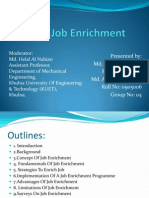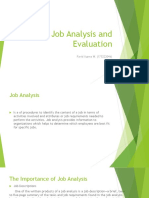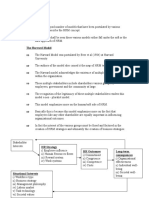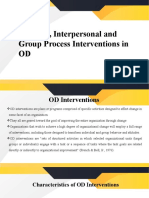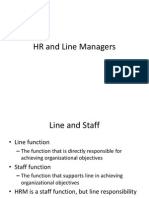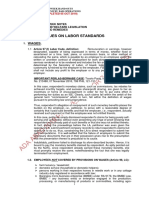0 ratings0% found this document useful (0 votes)
91 viewsJob Design Performance
Job Design Performance
Uploaded by
nabillaThe document discusses job design and its relationship to job performance and employee well-being. It defines job design as how tasks and decision-making authority are allocated to employees. A model is presented that describes job design in terms of horizontal and vertical dimensions. Strategies for job design discussed include job rotation, enlargement, enrichment, and self-managed teams, which aim to optimize both organizational and individual needs. Key factors in effective job design include task variety, autonomy, and interpersonal relationships.
Copyright:
© All Rights Reserved
Available Formats
Download as PDF, TXT or read online from Scribd
Job Design Performance
Job Design Performance
Uploaded by
nabilla0 ratings0% found this document useful (0 votes)
91 views18 pagesThe document discusses job design and its relationship to job performance and employee well-being. It defines job design as how tasks and decision-making authority are allocated to employees. A model is presented that describes job design in terms of horizontal and vertical dimensions. Strategies for job design discussed include job rotation, enlargement, enrichment, and self-managed teams, which aim to optimize both organizational and individual needs. Key factors in effective job design include task variety, autonomy, and interpersonal relationships.
Original Title
Job Design Performance
Copyright
© © All Rights Reserved
Available Formats
PDF, TXT or read online from Scribd
Share this document
Did you find this document useful?
Is this content inappropriate?
The document discusses job design and its relationship to job performance and employee well-being. It defines job design as how tasks and decision-making authority are allocated to employees. A model is presented that describes job design in terms of horizontal and vertical dimensions. Strategies for job design discussed include job rotation, enlargement, enrichment, and self-managed teams, which aim to optimize both organizational and individual needs. Key factors in effective job design include task variety, autonomy, and interpersonal relationships.
Copyright:
© All Rights Reserved
Available Formats
Download as PDF, TXT or read online from Scribd
Download as pdf or txt
0 ratings0% found this document useful (0 votes)
91 views18 pagesJob Design Performance
Job Design Performance
Uploaded by
nabillaThe document discusses job design and its relationship to job performance and employee well-being. It defines job design as how tasks and decision-making authority are allocated to employees. A model is presented that describes job design in terms of horizontal and vertical dimensions. Strategies for job design discussed include job rotation, enlargement, enrichment, and self-managed teams, which aim to optimize both organizational and individual needs. Key factors in effective job design include task variety, autonomy, and interpersonal relationships.
Copyright:
© All Rights Reserved
Available Formats
Download as PDF, TXT or read online from Scribd
Download as pdf or txt
You are on page 1of 18
Desain Pekerjaan
&
Kinerja
Dr. Audia Junita, M.Si.
A General Model of Job Design
This model describe the important determinants of job performance and organizational effectiveness.
The designing jobs is a complex process.
The way people do their jobs depends in part on how they perceive and think of their jobs.
Individuals react differently to jobs. While one person may derive positive satisfaction from a job,
another may not.
It also recognizes the difficult trade-offs between organizational and individual needs.
For example, the technology of manufacturing may dictate that management adopt assembly-line
mass production methods and low-skilled jobs to achieve optimal efficiency. Such jobs, however, may
result in boredom and worker discontent. Perhaps these costs could be avoided by carefully
balancing organizational and individual needs.
Job Design
Job design refers to the actual ‗content and method of jobs‘ that
employees perform in their jobs (Wall and Clegg, 1998, p. 337).
Job design refers to the process by which managers decide what job
tasks and how much authority each employee will have (Ivancevich et
al., 2014, p. 141).
Job design focuses directly on work-related tasks or activities that
employees undertake to design, produce and deliver a good or service
for the organization.
Jobs can be sources of psychological stress and even mental and
physical impairment. On a more positive note, jobs can provide income,
meaningful life experiences, self-esteem, esteem from others, regulation
of our lives, and association with others.
The well-being of organizations and people relates to how well
management designs jobs.
In this topic, we need to clarify what job each individual should be doing
and understand the causes of effective and ineffective job performance.
Core Dimension of Job Design
Job design decisions produce low or high levels of horizontal and vertical
job-related tasks or activities.
• The horizontal axis represents the functional or
technical tasks that are required to produce a
product or service. Job design choices can entail
only one simple task or a series of tasks combined
in one job (multiskilling and functional flexibility).
• The vertical axis, on the other hand, represents the
decision-making aspects of work activities, and
shows the extent of employees‘ autonomy in the
job. The extent to which the job allows employees to
exercise choice and discretion in their work runs
from low to high.
• The characteristics of job design A limit the content
or scope of the job, giving minimal, if any, discretion
over how work-related tasks are performed. The
focus is on a rapid completion of tasks and close
supervision.
• In contrast, job B is designed with more tasks and
offers the employee more autonomy over how those
tasks are performed. The focus is on improving job
satisfaction by allowing the worker to complete
several tasks with some self-supervision.
Job Design and Quality of Work Life
Quality of work life (QWL) is a management philosophy and practice
that enhance employee dignity, introduce cultural change, and provide
opportunities for growth and development.
QWL programs are intended to increase employee trust, involvement,
and problem solving so as to increase both worker satisfaction and
organizational effectiveness.
Indicators of quality of work life include accident rates, sick leave
usage, employee turnover, stress, and number of grievances filed.
The concept and application of QWL are broad and involve more than
jobs, but the jobs that people do are important sources of satisfaction.
Job design attempts :
(1) to identify the most important needs of employees and the
organization and
(2) to remove obstacles in the workplace that impede those needs.
Job Design: Range, Depth, and Relationships
Job range refers to the number of tasks a jobholder performs. The individual who
performs eight tasks to complete a job has a wider job range than a person performing
four tasks. In most instances, the greater the number of tasks performed, the longer it
takes to complete the job.
Job depth , the amount of discretion an individual has to decide job activities and job
outcomes. In many instances, job depth relates to personal influence as well as
delegated authority.
Job range and depth distinguish one job from another not only within the same
organization, but also among different organizations.
Lanjutan….Job relationship
Job relationships are determined by managers‘ decisions regarding
departmentalization bases and spans of control.
The wider the span of control, the larger the group and consequently
the more difficult it is to establish friendship and interest relationships.
The basis for departmentalization that management selects also has
important implications for job relationships. The functional basis
places jobs with similar depth and range in the same groups, while
product, territory, and customer bases place jobs with dissimilar
depth and range in different groups. Thus, in functional departments,
people will be doing much the same specialty. Thus, it‘s easier for
them to establish social relationships that are satisfying with less
stress, but also with less involvement in the department‘s activities.
Job relationship also closely related to group performance which is
affected in part by group cohesiveness which depends upon the
quality and kind of interpersonal relationships of jobholders assigned
to a task or command group.
Individual Differences
Individual differences ―provide filters such that different persons perceive
the same objective stimuli in different manners.
Employees with relatively weak higher-order needs are less concerned
with performing a variety of tasks than are employees with relatively
strong growth needs.
At some point, performance turns down as these individuals reach the
limits imposed by their abilities and time. The relationship between
performance and task variety (even for individuals with high growth
needs) is likely to be curvilinear.
Social Setting Differences
Differences in social settings of work also affect perceptions of job
content.
Examples of social setting differences include leadership style and
what other people say about the job.
Strategy to Increase Range in Jobs:
Job Rotation and Job Enlargement
1. Job Rotation
This practice involves rotating managers and non-managers alike from one job to
another, or to one or more international postings.
In so doing, the individual is expected to complete more job activities since each
job includes different tasks (task variety).
According to recent studies, increase employee satisfaction, reduce mental
overload, decrease the number of errors due to fatigue, improve production and
efficiency, and reduce on-the-job injuries.
2. Job Enlargement
Job enlargement strategies focus upon the opposite of dividing work—they‘re a
form of despecialization or increasing the number of tasks that an employee
performs.
For example, a job is designed such that the individual performs six tasks instead
of three.
Contemporary applications of job enlargement involve training individuals to
perform several different jobs, each requiring considerable skill, whether in
manufacturing or service organizations.
If employees are amenable to job enlargement and have the requisite ability, then
job enlargement should increase satisfaction and product quality and decrease
absenteeism and turnover.
Strategy to Increase Depth in Jobs:
Job Enrichment
Job enrichment means giving workers greater authority to participate
in decisions, to set their own goals, and to evaluate their (and their
work groups‘) performance.
Job enrichment also involves changing the nature and style of
managers‘ behavior.
Given employees‘ ability to carry out enriched jobs can bring up
positive outcomes lead to performance, that performance leads to
intrinsic and extrinsic rewards, and that these rewards have power to
satisfy needs.
Yet job enrichment, when appropriate, necessarily involves job
enlargement.
The Job Characteristic Model
(Hackman and Oldham)
Self-Managed Teams
Self-managed teams (SMTs) represent a job enrichment approach to
redesign at the group level.
An SMT is a relatively small group of individuals who are empowered to
perform certain activities based on procedures established and
decisions made within the group, with minimum or no outside direction.
Typically, SMTs determine their own work assignments within the team
and are responsible for an entire process from inception to completion.
SMTs can take many forms, including task forces, project teams, quality
circles, virtual teams, and new venture teams.
SMTs require not only a new workflow and set of processes, but also
new attitudes and behaviors.
Two notable barriers to SMTs are resistance and misunderstanding.
Team members may not like being responsible for goals that others on
the team have not helped to achieve.
Also, managers are often not clear about what employees should be
doing under an SMT arrangement.
Alternative Work Arrangements
One aspect of job context relates to when the job is performed, or the
work schedule.
Alternative work arrangements is implemented by giving employees
decision-making control over when they perform their work is an
increasingly popular approach to job redesign (work flexibility).
Alternative work arrangement give employee the flexibility to balance
their work–life demands and as a way to reduce organizational costs
and avoid layoffs that may lessen productivity and motivation.
It has led to a variety of innovations :
1. The compressed workweek, employees are given an opportunity
to work four 10-hour days rather than the more standard five 8-
hour days.
2. The flextime, employees are given greater individual control over
work scheduling, when they work at the office and when they work
from home or a cafe.
3. Job sharing (shift-work), two or more individuals share one job.
4. Telecommuting, involves working at home while being linked to the
office via a computer and/or fax machine.
Virtual Teams
It is a geographically distributed, functionally and/or culturally diverse group of individuals who
rely on interactive technology such as e-mail, Webcasts, and videoconferencing to work
together.
The benefits include decrease product cycle times, increase customer responsiveness, and
integrate more fully with suppliers, ability to offer employees more flexible work arrangements
(e.g., telecommuting), provide 24-hour-a-day, seven-day-a-week customer service for
geographically dispersed customers in different time zones, and decrease the amount of travel
time and expenses that team members have to incur many.
To successfully manage virtual teams, organizations may want to consider several factors :
1. The technology should fit the purpose of the collaboration, include a bulletin board or
group e-mail is appropriate (receive the same information quickly), a Web conference with
real-time white board and data sharing may be more suitable (training needs).
2. Virtual team members must be carefully selected who have the necessary skills,
experience, work ethic, and interpersonal skills is critical to effective team functioning.
3. Trust between team members should be cultivated early in the process. Face-to-face
meetings and/or teambuilding training exercises should be used during the initial periods of
team formation to facilitate the development of trust.
4. Teams need to develop a sense of purpose and shared goals.
5. Leaders must be able to set a vision for the team and help resolve conflicts between
members as well as assist members in overcoming obstacles.
Total Quality Management
Total quality management (TQM) refers to an organizational culture that is
dedicated to continuous improvement and the production of high-quality
products and services, ultimately resulting in higher levels of customer
satisfaction.
TQM combines technical knowledge and human knowledge.
To deal with the inherent complexity and variability of production and
service delivery technology, people must be empowered with authority to
make necessary decisions and must be enabled with knowledge to know
when to exercise that authority.
Two common techniques used in the implementation of TQM include
benchmarking and Six Sigma.
Benchmarking is the process in which organizations monitor and adapt the
best practices of their competitors in order to make continuous
improvements.
Six Sigma , is a quality standard and management process that specifies a
goal of no defects so that a product or process has reached a high level of
quality. Six Sigma can be used to analyze any product or service defects—
errors on billing statements, poor customer service, or faulty brake systems
on automobiles—that result in customer dissatisfaction.
Job Performance Outcomes
1. Objective Outcomes
Quantity and quality of output, absenteeism, tardiness, and turnover are objective outcomes
that can be measured in quantitative terms. For each job, implicit or explicit standards exist
for each of these objective outcomes.
2. Behavioral Outcomes
The jobholder reacts to the work itself. She reacts by either engaging fully in the job or by
―going through the motions.‖ Moreover, physiological and health-related problems, work
stress, physical and mental impairment, accidents and occupation-related disease can ensue
as a consequence of job performance.
3. Intrinsic and Extrinsic Outcomes
In a general sense, an intrinsic outcome is an object or event that follows from the worker‘s
own efforts and doesn‘t require the involvement of any other person.
Extrinsic outcomes, however, are objects or events that follow from the workers‘ own efforts in
conjunction with other factors or persons not directly involved in the job itself. Pay, working
conditions, co-workers, and even supervision are objects in the workplace that are potentially
job outcomes, but that aren‘t a fundamental part of the work. Dealing with others and
friendship interactions are sources of extrinsic outcomes.
It‘s generally held that extrinsic rewards reinforce intrinsic rewards in a positive direction
when the individual can attribute the source of the extrinsic reward to her own efforts.
4. Job Satisfaction Outcomes
Job satisfaction depends on the levels of intrinsic and extrinsic outcomes and how the
jobholder views those outcomes. These outcomes have different values for different people.
Individual differences (include job involvement and commitment to the organization), the
perceived equity of the organizational reward etc. play an important role to bring up
employee‘s job satisfaction.
Literatur
Bratton, John; Gold, Jeff. (2012). Human Resource
Management : Theory & Practice. Fifth Edition. Palgrave
MacMillan.
Ivancevich,J. M.; Konopaske,R.; Matteson, M.T. (2014).
Organizational Behavior and Mangement. Tenth Edition. New
York: The McGraw-Hill Companies, Inc.
Terima Kasih
You might also like
- Talent Management at Solar Industries: Case StudyDocument2 pagesTalent Management at Solar Industries: Case StudytinkatinkNo ratings yet
- Case StudyDocument5 pagesCase StudydreenajoycerosalesNo ratings yet
- Iles, P., Chuai, X. and Preece, D. (2010) 'Talent Management and HRM in Multinational Companies in Beijing: Definitions, Differences and Drivers', Journal ofDocument54 pagesIles, P., Chuai, X. and Preece, D. (2010) 'Talent Management and HRM in Multinational Companies in Beijing: Definitions, Differences and Drivers', Journal ofDinushika MadhubhashiniNo ratings yet
- Chapters 7-9 Journal Reflection SubmissionDocument5 pagesChapters 7-9 Journal Reflection SubmissionSachin VS0% (1)
- Job EnrichmentDocument16 pagesJob Enrichmenttanveerhossain1No ratings yet
- Career Development-Chapter 09 PDFDocument32 pagesCareer Development-Chapter 09 PDFMUHAMMAD SALEEM RAZANo ratings yet
- Module 8 - Career Development Succession Planning and Reward ManagementDocument13 pagesModule 8 - Career Development Succession Planning and Reward ManagementKiara Marie P. LAGUDANo ratings yet
- Employee EngagementDocument11 pagesEmployee EngagementManisha SinghNo ratings yet
- What Is Job Analysis? Why Is Job Analysis Important?Document18 pagesWhat Is Job Analysis? Why Is Job Analysis Important?Aljunex LibreaNo ratings yet
- Discretionary BehaviourDocument2 pagesDiscretionary BehaviourMarius TobaNo ratings yet
- Job Enlargement N EnrichmentDocument14 pagesJob Enlargement N EnrichmentrachealllNo ratings yet
- Deloitte Uk The Dna of Leadership Potential UpdatedDocument16 pagesDeloitte Uk The Dna of Leadership Potential UpdatedLucky TalwarNo ratings yet
- Job Analysis and Evaluation A NovidDocument13 pagesJob Analysis and Evaluation A NovidDimas FatmalaNo ratings yet
- Job PerformanceDocument8 pagesJob PerformanceEllegor Eam Gayol (girl palpak)No ratings yet
- E Ch6 Mathis Job AnalysisDocument64 pagesE Ch6 Mathis Job AnalysisNatik Bi IllahNo ratings yet
- Maslow - Applications and CriticismDocument6 pagesMaslow - Applications and CriticismDana Danutza100% (1)
- Explain How You Would Conduct A Job Analysis in A Company That Has Never Had Job DescriptionsDocument3 pagesExplain How You Would Conduct A Job Analysis in A Company That Has Never Had Job DescriptionsN. AzadNo ratings yet
- Chapter - 07 - Acertaining HR SupplyDocument15 pagesChapter - 07 - Acertaining HR SupplyImdad KhanNo ratings yet
- Employment Satisfaction Survey (ESS) in Measuring and Evaluating Employee Management ExpectationsDocument39 pagesEmployment Satisfaction Survey (ESS) in Measuring and Evaluating Employee Management ExpectationsChristopher M. LeeNo ratings yet
- ManagementDocument29 pagesManagementZIA UL REHMANNo ratings yet
- Performance Management Practices, Employee Attitudes and Managed PerformanceDocument24 pagesPerformance Management Practices, Employee Attitudes and Managed PerformanceMuhammad Naeem100% (1)
- The Labour Market ContextDocument30 pagesThe Labour Market Contextmansit26No ratings yet
- Which Leadership Type Is The Most Effective Transformational Transactional Taskfocused or People-FocusedDocument1 pageWhich Leadership Type Is The Most Effective Transformational Transactional Taskfocused or People-FocusedAlicjaONo ratings yet
- Job Enrichment NotesDocument9 pagesJob Enrichment Notesnilakshi_nillu100% (1)
- Future of Organization Development (OD)Document14 pagesFuture of Organization Development (OD)DkdarpreetNo ratings yet
- Reward ManagementDocument5 pagesReward ManagementmariabuttNo ratings yet
- Psychological Contract and Employee-Engagement in IndiaDocument15 pagesPsychological Contract and Employee-Engagement in IndiaPankaj VishwakarmaNo ratings yet
- Reward Management Unit 1Document6 pagesReward Management Unit 1Sravan Kumar Sharma PantulaNo ratings yet
- 7 Elements of Effective Performance ManagementDocument9 pages7 Elements of Effective Performance Managementsandeep k krishnanNo ratings yet
- Lecture 2, Challenges in SHRMDocument33 pagesLecture 2, Challenges in SHRMSrabon AhmedNo ratings yet
- Personal, Interpersonal and Group Process Interventions in ODDocument22 pagesPersonal, Interpersonal and Group Process Interventions in ODridhimaNo ratings yet
- Impact of Job Design On Employee Engagement: A Theoretical and Literature ReviewDocument6 pagesImpact of Job Design On Employee Engagement: A Theoretical and Literature ReviewAnonymous CwJeBCAXpNo ratings yet
- The International Journal of Human Resource ManagementDocument33 pagesThe International Journal of Human Resource ManagementAhmar ChNo ratings yet
- Cipd Performance AppraisalDocument7 pagesCipd Performance AppraisalRay VictorNo ratings yet
- Employee Performance and EvaluationDocument21 pagesEmployee Performance and EvaluationJessica KlingNo ratings yet
- Recruitment and SelectionDocument13 pagesRecruitment and SelectiondikshaNo ratings yet
- Implications of Strategic Human Resource ManagementDocument3 pagesImplications of Strategic Human Resource Managementtallalbasahel67% (3)
- Adapting The BSC To Fit The Public and Nonprofit SectorsDocument5 pagesAdapting The BSC To Fit The Public and Nonprofit SectorsLaine GhisNo ratings yet
- CompensationDocument25 pagesCompensationmonika khannaNo ratings yet
- HR and Line ManagersDocument11 pagesHR and Line ManagersrageshmvNo ratings yet
- OB 1st AssignmentDocument3 pagesOB 1st Assignmentjecinta wanjikuNo ratings yet
- Md. Awal Al Kabir Assistant Professor Jahangirnagar UniversityDocument27 pagesMd. Awal Al Kabir Assistant Professor Jahangirnagar UniversityJahedul IslamNo ratings yet
- Information Technology in Human Resource Management: A Practical EvaluationDocument6 pagesInformation Technology in Human Resource Management: A Practical EvaluationIjact EditorNo ratings yet
- 5CO01 Week1Slidesv2Document31 pages5CO01 Week1Slidesv2fedaNo ratings yet
- Chapter-1: A Study Team MotivationDocument60 pagesChapter-1: A Study Team Motivationsaikripa121No ratings yet
- Raging Debates in HR AnalyticsDocument5 pagesRaging Debates in HR AnalyticsNkvNo ratings yet
- Ovania Chemical CompanyDocument5 pagesOvania Chemical CompanyIshratJahanAonyNo ratings yet
- 2.2.1 Human Resource PlaningDocument25 pages2.2.1 Human Resource PlaningTewodros TadesseNo ratings yet
- Work Design and Job SatisfactionDocument6 pagesWork Design and Job Satisfactionnurezqi100% (1)
- Introduction To HR PlanningDocument13 pagesIntroduction To HR PlanningMd. Siddikur Rahman100% (1)
- A STUDY ON Employee Career PlanningDocument14 pagesA STUDY ON Employee Career PlanningSwetha ReddyNo ratings yet
- Performance AppraisalDocument81 pagesPerformance AppraisalIkhlaasKaushalNo ratings yet
- Module 3 Talent Management Including Performance Management and Human Resource OutsourcingDocument44 pagesModule 3 Talent Management Including Performance Management and Human Resource OutsourcingJennilyn Javier100% (1)
- ODDocument19 pagesODRachna RoomiNo ratings yet
- The Human Resources Management Strategies and Its Role in The AchievementDocument8 pagesThe Human Resources Management Strategies and Its Role in The Achievementindex PubNo ratings yet
- Effect of Work Life Balance On EmployeeDocument14 pagesEffect of Work Life Balance On Employeegarba shuaibuNo ratings yet
- Job Analysis - Definition, Importance, Components, Methods, Purpose, ProcessDocument37 pagesJob Analysis - Definition, Importance, Components, Methods, Purpose, ProcessShamsa ZahidNo ratings yet
- Performance Management 1Document21 pagesPerformance Management 1Dyah Anugrah KiranaNo ratings yet
- Chapter 8Document26 pagesChapter 8ahmadNo ratings yet
- Employee Referral Programs A Complete Guide - 2021 EditionFrom EverandEmployee Referral Programs A Complete Guide - 2021 EditionNo ratings yet
- IR Law Lesson #4Document9 pagesIR Law Lesson #4Debbie DebzNo ratings yet
- Labor Code - Cacho BookDocument6 pagesLabor Code - Cacho BookKarl CabarlesNo ratings yet
- TB 06Document47 pagesTB 06Ebtehal TamerNo ratings yet
- Salary Notes 2021-22Document10 pagesSalary Notes 2021-22Aman hingoraniNo ratings yet
- GenpactDocument8 pagesGenpactgurukul86No ratings yet
- Union Role in Wage AdministrationDocument11 pagesUnion Role in Wage AdministrationTeguh Sanjaya50% (2)
- Questions A B C D SolutionDocument2 pagesQuestions A B C D SolutionNIDHI KOTIANNo ratings yet
- Pakyaw Work JurisprudenceDocument2 pagesPakyaw Work JurisprudenceChil BelgiraNo ratings yet
- Final Part2 2019 Abad Labor Pre-Week Notes 100319Document57 pagesFinal Part2 2019 Abad Labor Pre-Week Notes 100319Liavel Badillo75% (4)
- 3738 11506 1 PBDocument10 pages3738 11506 1 PBBrian GiriNo ratings yet
- Mgt501 Mcqs HRM 100orrect Solved by Maha ShahDocument13 pagesMgt501 Mcqs HRM 100orrect Solved by Maha ShahAyesha AbdullahNo ratings yet
- HRMS3Document2 pagesHRMS3bugzzzNo ratings yet
- Formal Letter For Dole For NocDocument2 pagesFormal Letter For Dole For Nocricardo paculanNo ratings yet
- Compensation Performance Management - Appraisal - Unit-5Document53 pagesCompensation Performance Management - Appraisal - Unit-5WarhawkNo ratings yet
- MGT 5730 - Bella's Case - Instructions and Answer Sheet-1Document10 pagesMGT 5730 - Bella's Case - Instructions and Answer Sheet-1Sana NoorNo ratings yet
- Unit 2: Acquiring Human ResourcesDocument120 pagesUnit 2: Acquiring Human ResourcesVanisha MurarkaNo ratings yet
- Resea RRR CHDocument4 pagesResea RRR CHimsana minatozakiNo ratings yet
- Form - Request For Sole & Exclusive Bargaining Agent (SEBA)Document2 pagesForm - Request For Sole & Exclusive Bargaining Agent (SEBA)Cholophrex SamilinNo ratings yet
- Employee HR Policies in Hospitality Industries: (With Special Refrence To OYO)Document60 pagesEmployee HR Policies in Hospitality Industries: (With Special Refrence To OYO)ANKIT saran saran jat100% (2)
- Incentives To Private Sector Employers For Providing Employment To Persons With DisabilitiesDocument3 pagesIncentives To Private Sector Employers For Providing Employment To Persons With DisabilitiesRgirish 1No ratings yet
- Assignment On Labour LawDocument6 pagesAssignment On Labour LawToma ChowdhuryNo ratings yet
- GA03 - Risk AssessmentDocument2 pagesGA03 - Risk AssessmentStephen D W RothNo ratings yet
- Employment (Conditions of Employment) Regulations 1991 (S.I. 34 of 1991)Document29 pagesEmployment (Conditions of Employment) Regulations 1991 (S.I. 34 of 1991)Gamanson ElpitiyaNo ratings yet
- SAN MIGUEL CORPORATION vs. ABALLADocument1 pageSAN MIGUEL CORPORATION vs. ABALLAAreeNo ratings yet
- Studies and Award Verification Service: Henry ContehDocument2 pagesStudies and Award Verification Service: Henry ContehTamba KendemaNo ratings yet
- Group 08 - Final ProjectDocument20 pagesGroup 08 - Final ProjectRomali DasNo ratings yet
- 2316 2021 Provi Newly HiredDocument99 pages2316 2021 Provi Newly HiredDelio Amante Jr.No ratings yet
- GFM PF CHAPTER 1 2024 QuestionsDocument17 pagesGFM PF CHAPTER 1 2024 QuestionsJayant MishraNo ratings yet




